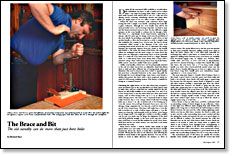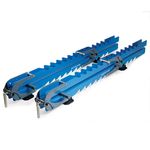The Brace and Bit
This old standby can do more than just bore holes
Synopsis: Despite all the motorized drills available to woodworkers, the old-fashioned bit brace is still a useful tool, writes Richard Starr, who uses his for boring holes. He details their history and variations and explains how to pick the right one. He advises getting one with a good chuck, and offers direction on the astounding variety of chuck designs. Then he explains how to use it to bore a hole, how to select auger and expansion bits, and how to cut tenons and drive screws with them.
Despite all the motorized drills available to woodworkers, the old-fashion bit brace is still a useful tool in today’s shop. I use mine for boring holes when I don’t want to mess with a power cord, and it’s fun to use, too. I also use it for driving screws, tenoning, chamfering dowels and doing other jobs you might expect to do on a lathe or with a drill press.
Before the brace was invented, early craftsmen drove large boring bits with a simple cross handle, something that looks like a giant corkscrew. Although the cross handle may still be the most powerful tool to use for boring a big hole, it is hard to steer and the hand-over-hand motion is slow. It’s also difficult to apply pressure on the cross handle to advance the bit through a hole. The brace is a surprisingly recent improvement, appearing in Europe only 600 years ago. Its design overcomes the problems of the cross handle by providing a top handle to push down on and another handle to drive the bit around in a circle. A simple crank that multiplies the rotating force of your arm, the brace’s sweep (sometimes called swing) is the diameter of the circle your powering hand travels around the tool. To determine the sweep, measure the horizontal distance from the chuck to the handle and double it. The wider the sweep of the brace, the more your efforts are multiplied and the more torque (or rotary force) the brace puts out. Although a wide-sweep brace is more powerful, there is a trade-off: Your hand must travel in a larger diameter circle, so a wide-sweep brace bores slower than a brace with a narrower sweep. Thus, wide-sweep braces bore big holes better, while narrow ones bore smaller holes more quickly.
Unlike cross handles, which have one bit permanently attached to the end of a shaft, braces have an adjustable chuck that allows them to hold and drive different bits of varying shank styles and diameters. Bits used in braces may have round or square shanks, but most have a threaded leadscrew in the center that pulls the bit through the wood during boring. Some braces even feature a ratchet that powers the brace with a short reciprocal stroke instead of a full-sweep cranking motion. This feature is helpful for boring in a cramped location.
From Fine Woodworking #71
For the full article, download the PDF below:
Fine Woodworking Recommended Products

Rockler Deluxe Panel Clamp

Stanley Powerlock 16-ft. tape measure

Veritas Wheel Marking Gauge






















Log in or create an account to post a comment.
Sign up Log in